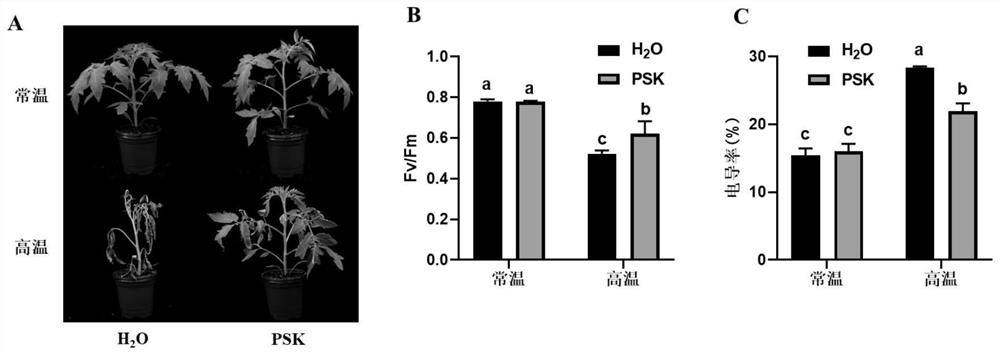Application of polypeptide receptor PSKR1 gene in improving high-temperature adversity resistance of tomato plant and/or tomato pollen
A gene and tomato technology, applied in the biological field, can solve the problems of tomato's poor heat resistance and achieve the effect of improving resistance and high temperature stress resistance
- Summary
- Abstract
- Description
- Claims
- Application Information
AI Technical Summary
Problems solved by technology
Method used
Image
Examples
Embodiment 1
[0034] Construction and identification of PSKR1 gene overexpression vector and tomato plants
[0035] The coding sequence of the PSKR1 gene (Solyc01g008140) was obtained according to the tomato genome database (https: / / solgenomics.net / ). The nucleotide sequence of the protein coding region is shown in SEQ ID NO.1, and the amino acid sequence of the protein encoded by the PSKR1 gene is shown in shown in SEQ ID NO.2. Referring to the Gateway manual, Primer5 software was used to design the upstream primer (SEQ ID NO.3): 5'>TTggcgcgccATGGTGATTTGGGAGTTTCT>3' and the downstream primer (SEQ ID NO.4) 5'>CGGggtaccCCTCTCCTTTACACTTGCGATTG>3'.
[0036] RNA was extracted from tomato leaves, and cDNA was obtained by reverse transcription. Using the cDNA as a template, the full-length coding region of the tomato PSKR1 gene was amplified by PCR using the upstream and downstream primers. On the vector pFGC1008-3HA, the expression vector pFGC1008-3HA is specifically: three HA-tagged proteins a...
Embodiment 2
[0038] Study on high temperature stress resistance of plants overexpressing PSKR1 gene
[0039] Place 3-4 week old tomato seedlings in an artificial climate incubator with 12 hours of light and 12 hours of darkness, light intensity 200 μmol m -2 s -1 , the temperature is set to the high temperature treatment of 45 ℃ or the normal temperature treatment of 25 ℃, during which water is added in time to prevent the seedlings from drying out. Two days later, it was found that the wild-type control plant WT wilted more seriously than the PSKR1 gene overexpressing plants OE:PSKR1-1 and OE:PSKR1-2 under high temperature conditions. Representative plants were selected to take pictures, and the maximum photochemical efficiency (Fv) of PSII in tomato plants was determined. / Fm) and relative conductivity.
[0040] Among them, the maximum photochemical efficiency (Fv / Fm) of plant PSII was determined as follows: after tomato plants treated at different temperatures were placed in a dark en...
Embodiment 3
[0044] Effects of exogenous treatment of plant polypeptide PSK on high temperature stress resistance of plants
[0045] Slowly add 0.85g of PSK to 100mL of water, stir until fully dissolved to obtain a mixed solution; add 9.9L of water and 2.5mL of silicone to the 100mL mixed solution and mix to form a diluted solution (preparation working solution) before use.
[0046] The preparation working solution was evenly sprayed on the surface of the tomato leaves with five leaves and one heart, until the leaves on both sides were completely wet, and the preparation working solution did not flow down in the form of water droplets. tomato plants served as controls.
[0047] Different temperature treatments were performed on tomato plants after exogenous spraying of PSK and control treatments. Tomato plants were placed in an artificial climate incubator with a light intensity of 200 μmol m -2 s -1 , the temperature is set to 45 ℃ high temperature treatment or 25 ℃ normal temperature ...
PUM
 Login to View More
Login to View More Abstract
Description
Claims
Application Information
 Login to View More
Login to View More - R&D
- Intellectual Property
- Life Sciences
- Materials
- Tech Scout
- Unparalleled Data Quality
- Higher Quality Content
- 60% Fewer Hallucinations
Browse by: Latest US Patents, China's latest patents, Technical Efficacy Thesaurus, Application Domain, Technology Topic, Popular Technical Reports.
© 2025 PatSnap. All rights reserved.Legal|Privacy policy|Modern Slavery Act Transparency Statement|Sitemap|About US| Contact US: help@patsnap.com



